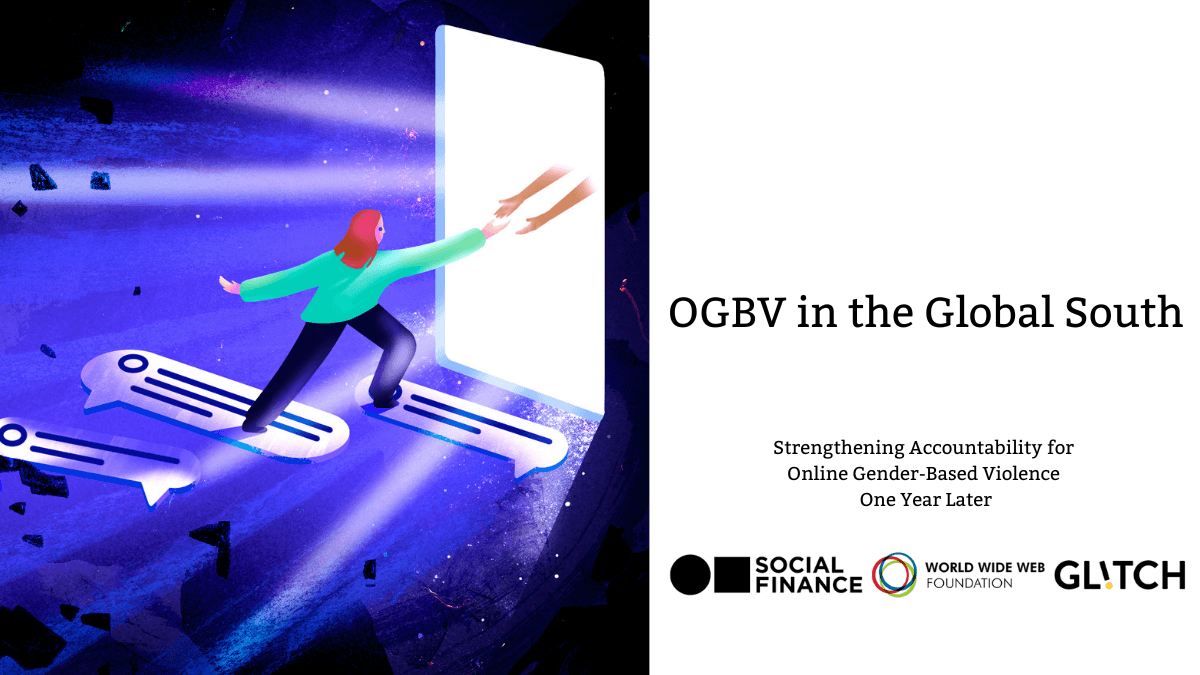OGBV in the Global South
Any efforts to address OGBV need to consider the particular context of OGBV in the Global South. Africa (Central, Eastern, Western, Southern) Regional Context In Sub-Saharan Africa (SSA), home of numerous Least Developed Countries (LDCs), the digital divide is particularly …

Any efforts to address OGBV need to consider the particular context of OGBV in the Global South.
Africa (Central, Eastern, Western, Southern)
Regional Context
In Sub-Saharan Africa (SSA), home of numerous Least Developed Countries (LDCs), the digital divide is particularly high with only 19% of women using the internet in 2020, compared to 86% in more developed countries. Women are also 14% less likely to own a mobile phone than men and are less likely to utilise mobile data, social media applications or SMS services. However, despite this glaring disparity in online use and access, the few women online are most exposed to OGBV from both local and international perpetrators.
SSA continues to face inequalities which reflect the disparities present in the technology landscape including in policy making processes and technology development.
Across the continent, there are prevailing similarities in the contexts that inform the experiences of women online including on OGBV. These challenges mirror the impediments women often face in the offline world including access to education and economic opportunities, participation in civic processes, or in claiming their freedom of expression and assembly. Among the dominant forms of OGBV include trolling, insults, body shaming, sexualised, and gendered abuse.
Despite these disparities, more women face various forms of online violence than men, resulting in poor engagement and active participation online. The absence of laws designed to specifically address the various forms of digital violence (such as non-consensual sharing of intimate images, trolling, bullying, and harassment) and the lack of sufficient in-country reporting mechanisms, exacerbate these challenges and often result in many women being forced to go offline or resorting to self-censorship. Meanwhile, limited awareness of platform specific responses to addressing OGBV only serve to further the perception of hopelessness in the face of online assaults.
Facebook ranks as one of the primary platforms for social media use – indeed, for many, it serves as a gateway to the greater internet. However, in different countries, and indeed for different contexts, the way in which OGBV manifests will be experienced differently by various segments of women online such as politicians, entertainers, journalists, business women, young girls and refugees etc. For example, during the 2021 elections in Uganda, women politicians were more likely to experience OGBV on Twitter more than on Facebook. However, women politicians in the country prefered using Facebook over Twitter to engage with voters. Some of the efforts made by Facebook to encourage women politicians include page verification . However, for many, these efforts remain insufficient.
Research on OGBV in Ethiopia, Kenya, Uganda, Senegal and South Africa showed that most incidents occurred on Facebook. Further, In Kenya, Uganda, Senegal and South Africa, OGBV happens primarily on Facebook and Whatsapp.
Indeed, a global study which included Sub-Saharan African countries like Burkina Faso, Kenya, Malawi, Togo, and Zambia noted that these online experiences are a shared global concern. The study also highlighted that OGBV is most common on Facebook with 39% of the respondents sharing this concern. Respondents in the survey also noted other platforms including Instagram (23%), WhatsApp (14%), Snapchat (10%), Twitter (9%) and TikTok (6%) as typical places for OGBV.
Selected Reports
- In Search of Safe Spaces: This research focused on documenting the nature of challenges faced by Ugandan women who are active online, manifestations of cyber Violence Against Women (VAW), and how online groups can be leveraged to enhance women’s paritipation.
- Alternate Realities, Alternate internets: This paper researched the online lived experiences of women living in five sub-Saharan Africa to illustrate that repeated negative encounters fundamentally impact how women navigate and utilize the internet. This in turn, strengthens the argument for a radical shift in developing alternate digital networks grounded in feminist theory.
- Understanding Online Gender-based Violence in Southern Africa: This study investigates the prevalence of the phenomenon of online violence against women in the Southern African region. The study focuses on the following eight (8) countries Angola, Botswana, Malawi, Mozambique, Namibia, South Africa, Zambia, and Zimbabwe. NB: Supported by Meta
- Women’s Rights Online Digital Gender Gap Audit Scorecards assesses the policy efforts and progress made in select countries.
- Silent No More! Africa’s Feminist Voices Are Growing Louder: While existing inequalities are rooted in tradition and social mores, many more are maintained by religious and educational institutions and in some instances reinforced by outdated national laws. These structures of inequality were among the issues discussed at the Forum on Internet Freedom in Africa (FIFAfrica) 2019 during sessions on feminism in Africa and women’s digital leadership.
Asia Pacific (Central, South, Northeastern, Southeastern Asia, Oceania)
Regional context
Across the Asia Pacific region and in line with global trends, women are experiencing a high prevalence of OGBV and tech-facilitated abuse. A landscape analysis conducted in 2022 found that OGBV in Asia constitutes a myriad forms of abuse, violence, and harassment is largely shaped by key societal norms and values as well as the evolving landscape of technology use in the region.
With regard to reporting and help-seeking behaviours, researchers from the Asia-Pacific region identify significant barriers including poor awareness of reporting mechanisms; perceptions that platforms would not do anything; and a perception that filing a report is cumbersome and complex.
At the local law enforcement and policy level, government authorities across the region are implementing policy and program responses to address OGBV. However, as in other regions, they struggle to create cohesive laws and timely policies that capture the complexity of the issue. This leads to a landscape where definitions of OGBV and responses across the region are disjointed, outdated, or non-existent in the laws.
At the community level, many community settings like schools and workplaces are found to lack appropriate support mechanisms for survivors and are underutilized in response and prevention against OGBV. While education settings could serve as important resourcing for children and youths, educators often lack the knowledge and curriculum to teach students about online safety and OGBV prevention.
In addition to that, not many individuals turn to their families or greater community for support after experiencing OGBV due to embarrassment, lack of empathy, and fear of re-victimization. This behaviour is entrenched further by gendered social norms and patriarchal structures that create stigma with experiencing violence often being seen as a private matter.
Familial and kinship dynamics also shape the context of OGBV in Asia. Policing and surveillance of online activities by family members and kinship networks can often be seen in “honor cultures” where, for instance, brothers position themselves as protectors of their sisters, guarding their mobility and dignity for the sake of family honor.
Varying levels of digital literacy among parents may weaken their ability to provide guidance and oversight on computer and internet use and support. This has been found to be linked to an increased risk of exposure among children and adolescents to cyberbullying, harmful content, and sexual exploitation.
Selected Reports
- Landscape Analysis of Technology-Facilitated Gender Based Violence: A review of peer-reviewed and grey literature across Asia, conducted by USAID. The initial scope of the review included Central Asia and the Pacific Islands, however, due to a lack of reports and evidence from those regions, the report focus on South and Southeast Asia and includes case studies on Bangladesh, India, Indonesia and Thailand
- Born digital, born free? A socio-legal study on young women’s experiences of online violence in South India: A study by IT for Change which explores how gender regimes operate in digitally-mediated social interactions, unravelling the nature of cyberviolence, and evaluating the effectiveness of prevailing legal-institutional response mechanisms.
- Measuring Pakistani Women’s Experiences of Online Violence: A quantitative research study on online gender-based harassment in Pakistan by the Digital Rights Foundation
- Troll Patrol India: Exposing Online Abuse Faced by Women Politicians in India: Using crowd-sourced research and data science, Indians forAmnesty International Trust in collaboration with Amnesty International – International Secretariat (AI-IS) measured the scale and nature of online abuse faced by women politicians in India during the 2019 General Elections of India.
- Online Sexual Harassment over Anonymous Social Media in Bangladesh: A study that finds the majority of Bangladeshi women participants complained about being sexually harassed over social media, receiving messages that were categorized as either sexual prepositions, sexually objectifying contents, romantic messages, or dating inquiries.
- Report of Expert Consultation Responding to Violence against Women and Girls in the Cyber Age: A report that sets out the key points discussed at an expert consultation involving practitioners in the areas of law, media, technology and women’s rights and focusing on the nature and scope of online speech and harassment of women and girls in Bangladesh.
- Cambodia, Malaysia, Pakistan and the Philippines: Cross-Country Study on Violence against Women and Information Communication Technologies: A cross-country study highlighting the ability to widely disseminate intimate images through online platforms is a factor that allows perpetrators to blackmail and shame targets, for purposes ranging from remaining in romantic relationships with existing intimate partners or sharing images fll-known public figures and actresses.
Latin America / Caribbean
Regional context
In Latin America there are over 430 million internet users. Regarding specific platforms used in the region, in 2020 the market share of Facebook and Pinterest mostly decreased in the region, while Instagram, Twitter, and especially YouTube increased. In that context, the country with the highest percentage of its population on social media is Chile, where more than 90 percent of people are on social media, and the country with the most social media users is Brazil, with approximately 160 million internet users as of January 2021. With regard to Brazil, it is interesting to note that it is also the country with the lowest social media penetration rate at 70.3 percent.
In regards to online violence, women are at the head of a ranking of the victims of online violence: 95% of aggressive behaviours of harassment, interference, psychological persecution and profanity with words and images in online spaces are directed at women and come from of male partners or former partners. In addition, there is a large number of communication systems that are used to exercise violence against women, among which are spyware, wireless technology for listening, visual surveillance (with hidden cameras and webcams), tracking with wireless devices in cars, cell phones, among others.
A study of the United Nations, in cooperation with ADC and various civil society organizations (Asociación por los Derechos Civiles (ADC), Coding Rights, Derechos Digitales, Hiperderecho, Fundación Karisma, InternetLab, IPANDETEC, Red en Defensa de los Derechos Digitales (R3D), TEDIC, & Paz) in the Americas, indicates that online violence is institutionalized in the Americas at different levels, and it worsens when considering the intersectionality of variables such as ethnicity, social class, age and place of residence.
Thus, technology has become an enabling tool for gender-based violence extending the offline attacks to the virtual space. Women are vulnerable in both spheres. There are multiple forms of online gender based violence attacks against women used in the Americas, including disinformation, cyberstalking and cyber extortion. According to Acoso.online (2021), the dissemination of intimate content without consent is the most widespread type of online gender-based violence in the Americas. To analyze online gender-based violence we must also consider that each country has its own sociopolitical and informational systems, moreover certain groups are most affected by this type of violence based on the intersection of vulnerabilities, particularly in the Americas, ethnicity, sexual orientation, gender identity, language and disability.
In recent years, various countries in Latin America and the Caribbean have begun a gradual recognition of online violence against women and have updated their legal framework to deal with it, including the enactment of specific laws on grooming and cyberbullying.
Particularly, due largely to the attention paid by the media and the demands of public opinion, throughout Latin America and Caribbean there have been important legislative advances regarding the non-consensual distribution of intimate or sexually explicit images (Neris et al., 2018). In recent years, progress has been seen in several countries in the formation of police bodies specialized in cybercrime, which can investigate acts of online violence against women.
However, with the pandemic this situation had a boost, as many of the social interactions went digital, violence both at home and online increased.
Selected Reports
- Women’s Observatory Against Disinformation and Fake News (initiative of Fundacion Multitudes): Two studies which showed that 96.8% of women parliamentarians and 64.1% of women members of the Constitutional Convention in Chile said they have been victims of disinformation as a form of online gender-based violence. These findings prove that disinformation campaigns nullify the civic and political rights of women, and affect their livelihoods. Thus, disinformation poisons the public environment and results in low female political participation as women feel endangered by false and harmful content online.
- Proyecto Amaranta: A study in 2019 which showed that 73.8% of the women surveyed (cis, trans, non-binary), stated they had experienced violence in digital spaces. The most reported attacks were verbal violence, harassment and/or stalking, sending videos or pictures of penises without consent, defamation of women, account loss or non-consensual access by third parties, account suspensions due to mass complaints, identity theft, doxing, use of their body or face to create humiliating images, and disclosure of intimate images without consent.
- Covid-19 and the increase of domestic violence against women in Latin America: A study by Derechos Digitales showing that Latin America and the Caribbean have particularly experienced a high increase in violence against women and girls. According to CEPAL and UN Women Latin America has the highest rates of gender-based violence in the world, with Brazil, Peru, Mexico, Argentina, El Salvador and Bolivia representing 81% of all cases.
- Acoso.online study on telework: According to this study in Chile, México, Colombia, Guatemala, Peru, Bolivia, Ecuador, España, El Salvador and Uruguay, 32% of respondents identify the telework place as a space for domestic violence. In particular, 83% have been victims of violence in this environment and 17% identify that they know a person that has been a victim of this type of violence. In addition, 41 % of the respondents to the survey have experienced gender-based cyberbullying in the telework space.
MENA Region
Regional context
Although OGBV is a rampant issue in the region, it is somewhat a new research area that has no standard normative framework. Women with better access to the digital world, such as young, educated and working women seem to be more exposed to online gender-based violence. In addition to this, intersecting identities and forms of discrimination can worsen online GBV and repercussions for survivors. In that regard, women who are challenging entrenched patriarchal norms, such as non-binary women, women’s human rights defenders and single women, face heightened risks of specific forms of online violence. Within the MENA region, men, the state and state actors remain the main perpetrators of online gender-based violence. Contextual differences can be however observed across the countries, especially in those countries like Syria where online violence is closely connected to the conflict setting, or in Palestine where the occupation exacerbates the repercussions of OGBV in the digital space. Nevertheless, common trends can be identified to provide a basis for further research or for new action plans at the national, regional, and global levels. The core common trends are the following:
Legal reforms do not enable flexible interpretations: At a domestic level, national legal provisions do not address violence against women in a comprehensive and consistent way despite the ratification of international conventions, such as CEDAW. OGBV remains overlooked or strictly limited to the family context and/or protection measures that are difficult to access, interpret and implement. If anything, efforts to address OGBV often gear towards criminalisation which can result in lengthy judicial proceedings, lawsuits that do not amount to any damages paid, reliving trauma or even bringing more attention to the concerning content in the first place.
Access to justice remains a rocky road for women: In a context where women already find it difficult to file a complaint fearing stigmatisation and bearing the weight of patriarchal mentalities, rural and urban discrepancies still challenge access to justice. Additionally, governments throughout the region seem to amend cyber-crime laws and online hate speech provisions to silence dissent and undermine freedom of expression (e.g. in Palestine, Jordan, Algeria, Morocco, Turkey and Egypt). This creates additional obstacles to accessing justice and contributes to a hostile environment toward women’s rights and gender equality.
Ill-defined role of internet intermediaries in Arabic-speaking countries: Social media adapt their rules in each country and region and often rely on self-governance, but governments are increasingly keen on regulating social media platforms through ad hoc agreements or specific bills. The latter often gives the state the power to monitor online content which has serious implications for women’s journalists, women’s human rights defenders, and feminist groups in general. Furthermore, Arab activists and journalists, many of whom use social media to document human rights abuses and war crimes, are routinely censored and booted off the platform — most commonly under the pretext of terrorism.





































